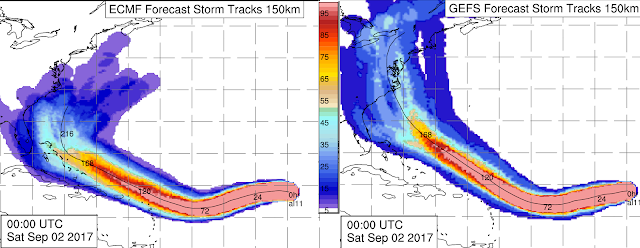Since last Tuesday, the key message associated with Harvey was that historic rainfall and catastrophic flooding was expected over a large area in eastern Texas. That message remained steady, even when Harvey was a tropical depression, and through its Category 4 hurricane landfall. Unfortunately, now we are seeing the beginnings of that outlook come to fruition.
Overnight, the Houston area experienced unimaginably heavy rain, over 20 inches in some places in just a few hours. The city is literally underwater today. And there are days more of rain to come. This is far from over.
 |
| Rainfall totals from Friday morning through Sunday morning. |
Harvey is still forecast to remain stationary for the next few days... perhaps starting to drift northward on Wednesday. The heavy rainfall we've been seeing is not going to end anytime soon. The forecast for the next five days shows that areas around Houston could see an additional 1-2 feet of rain.
As of Sunday morning, Harvey is still a tropical storm with 45mph winds, and is centered about 65 miles east-southeast of San Antonio, 130 miles west-south of Houston, and 80 miles north of Corpus Christi. But the specific storm center is not the concern, it's the sprawling rainbands that extend outward for hundreds of miles. Since the storm is still so close to water, the circulation is drawing in tropical moisture from the steamy Gulf of Mexico... an endless fuel source.
Aside from the torrential rain that rainbands produce, they are also well-known to produce tornadoes. At least a dozen tornadoes have been reported in eastern Texas and western Louisiana since Saturday morning.
The latest forecast and warnings can be found on the
National Hurricane Center website. I have long regional radar loops available at
http://andrew.rsmas.miami.edu/bmcnoldy/tropics/radar/
There have been the usual "this came out of nowhere" and "we didn't think it would be this bad" statements from officials. This is very unfortunate and irresponsible... this event was very well forecast and advertised for several days in advance. Forecasts of widespread 15-20" totals with some areas seeing 40 inches or more will verify.
As someone who tries to get this information out, it's frustrating and infuriating when people who should know better claim they had no warning. The general public seems to fear the category rating of a storm more than the rainfall forecast, yet rain is historically responsible for 3.3 times more fatalities than wind for hurricanes hitting the United States. Storms like Harvey may help to make the public more aware that rain is a very big deal, even though it's not a part of the Saffir-Simpson category rating.
To give an idea of how consistent the messaging has been, here are some quotes from my posts since Friday the 18th (still lots of uncertainty on the 18th):
Aug 18: "Beyond the Yucatan peninsula encounter, things get hazy... but the possibility exists that it could become a hurricane in the Gulf of Mexico in about a week."
Aug 22: "Even if Harvey does not reach hurricane intensity, the rainfall associated with it is still expected to be a big problem. Over coming week, large areas from the Mexico border over to the north-central Gulf coast could see very substantial rainfall totals."
Aug 23: "By far, the hazard of greatest concern with this system is its rainfall. While the center of the storm is expected to reach the coast Friday afternoon, heavy rain is likely to begin in the morning. Because of weak atmospheric steering currents, computer models indicate Harvey will stall over the Texas-Louisiana area through most of the weekend, at least, dispensing potentially incredible amounts of rain. ... Some computer model forecasts suggest the storm could linger over Texas through early next week, producing astronomical rainfall amounts between 30 and 50 inches in areas."
Aug 24: "In addition to damaging winds, the National Hurricane Center said it expects “catastrophic and life-threatening” flash flooding along the middle and upper Texas coast. An incredible amount of rain, 15 to 30 inches with isolated amounts of up to 40 inches, is predicted because the storm is expected to stall and unload torrents for four to six straight days. In just a few days, the storm may dispense the amount of rain that normally falls over an entire year, shattering records."
Aug 25: "The impacts from this storm are anticipated to be almost unfathomable. A storm of this intensity would be bad enough, but all guidance suggests that it will stall for several days right near the coast due to a lack of mid-level steering winds. The rainfall forecasts are ominous, and if they come even close to verifying, this will be a storm for the history books. In this map below, which shows the cumulative rainfall forecast over the coming week, a large area is saturated at the >20 inches contour, but specific locations could see 3-4 FEET of rain. Widespread and prolonged life-threatening flooding appears inevitable."
Aug 25: "Hurricane Harvey could be on par with 2005’s Hurricane Katrina in terms of economic impact. The Houston area and Corpus Christi are going to be a mess for a long time."
Aug 26: "A stationary tropical cyclone is a very bad thing... and widespread life-threatening flooding is anticipated over the coming days. The latest 5-day rainfall forecast places over 20 inches of rain in the same areas that have been getting heavy rain since Friday morning. Locations within this area could see up to 40 inches. Flooding might not be as dramatic as a hurricane making landfall, but it's more deadly."
The point of rehashing this is certainly not to say "I told you so", but rather to discredit the irresponsible and inaccurate messages coming out now that the event is actually happening. This did not catch anyone offguard. It could be the greatest flooding disaster in U.S. history.


















































